Handbook of the Hemopoietic Microenvironment
Mehdi Tavassoli
Dec 2012 · Contemporary Biomedicine Book 9 · Springer Science & Business Media
Ebook
454
Pages
reportRatings and reviews aren’t verified Learn More
About this ebook
In 1868, Ernst Neumann recognized that blood cells re quire continuous replenishment during postnata1life. Before him, the assumption was that cells of the blood, like nerves once formed in the embryo, remain in the body throughout life. Neumann also recognized that this process occurred within the bone marrow, because this tissue provided a fa vorable environment for proliferation and differentiation of blood cell precursors. Vera Danchakoff, the Russian embryologist working in the US, in 1916 made an analogy to the soil and the seed. Bone marrow forms the soil, providing a favorable environment for the growth of seed, the hemopoietic stem cell, and other progenitor cells. Imagine in the remote past a heap of similar tree seeds. These seeds develop in our moderate climate into a tall and many branched tree. Suppose the wind bears a part of the seeds away and brings them to a land possessing different environmental conditions, we will say the arc tic lands. There the seeds may develop but they may pro duce trees no higher than our moss.
Rate this ebook
Tell us what you think.
Reading information
Smartphones and tablets
Install the Google Play Books app for Android and iPad/iPhone. It syncs automatically with your account and allows you to read online or offline wherever you are.
Laptops and computers
You can listen to audiobooks purchased on Google Play using your computer's web browser.
eReaders and other devices
To read on e-ink devices like Kobo eReaders, you'll need to download a file and transfer it to your device. Follow the detailed Help Center instructions to transfer the files to supported eReaders.








